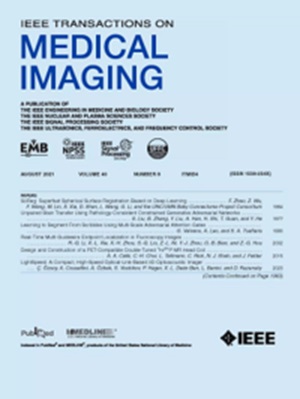RibSeg v2:肋骨标记和解剖中心线提取的大规模基准
IF 8.9
1区 医学
Q1 COMPUTER SCIENCE, INTERDISCIPLINARY APPLICATIONS
引用次数: 1
摘要
自动肋骨标记和解剖中心线提取是各种临床应用的常见先决条件。先前的研究要么使用社区无法访问的内部数据集,要么专注于肋骨分割,忽略了肋骨标记的临床意义。为了解决这些问题,我们将二进制肋骨分割任务的先前数据集(RibSeg)扩展到一个名为RibSegv2的综合基准,共有660个CT扫描(共15466个肋骨)和专家手动检查的注释,用于肋骨标记和解剖中心线提取。基于RibSeg v2,我们开发了一个流水线,包括基于深度学习的肋骨标记方法和基于骨架化的中心线提取方法。为了提高计算效率,我们提出了一种CT扫描的稀疏点云表示,并将其与标准的密集体素网格进行了比较。此外,我们设计和分析评估指标,以应对每项任务的关键挑战。我们的数据集、代码和模型可在线获取,以促进开放式研究https://github.com/M3DV/RibSeg.本文章由计算机程序翻译,如有差异,请以英文原文为准。
RibSeg v2: A Large-scale Benchmark for Rib Labeling and Anatomical Centerline Extraction
Automatic rib labeling and anatomical centerline extraction are common prerequisites for various clinical applications. Prior studies either use in-house datasets that are inaccessible to communities, or focus on rib segmentation that neglects the clinical significance of rib labeling. To address these issues, we extend our prior dataset (RibSeg) on the binary rib segmentation task to a comprehensive benchmark, named RibSeg v2, with 660 CT scans (15,466 individual ribs in total) and annotations manually inspected by experts for rib labeling and anatomical centerline extraction. Based on the RibSeg v2, we develop a pipeline including deep learning-based methods for rib labeling, and a skeletonization-based method for centerline extraction. To improve computational efficiency, we propose a sparse point cloud representation of CT scans and compare it with standard dense voxel grids. Moreover, we design and analyze evaluation metrics to address the key challenges of each task. Our dataset, code, and model are available online to facilitate open research at https://github.com/M3DV/RibSeg.
求助全文
通过发布文献求助,成功后即可免费获取论文全文。
去求助
来源期刊

IEEE Transactions on Medical Imaging
医学-成像科学与照相技术
CiteScore
21.80
自引率
5.70%
发文量
637
审稿时长
5.6 months
期刊介绍:
The IEEE Transactions on Medical Imaging (T-MI) is a journal that welcomes the submission of manuscripts focusing on various aspects of medical imaging. The journal encourages the exploration of body structure, morphology, and function through different imaging techniques, including ultrasound, X-rays, magnetic resonance, radionuclides, microwaves, and optical methods. It also promotes contributions related to cell and molecular imaging, as well as all forms of microscopy.
T-MI publishes original research papers that cover a wide range of topics, including but not limited to novel acquisition techniques, medical image processing and analysis, visualization and performance, pattern recognition, machine learning, and other related methods. The journal particularly encourages highly technical studies that offer new perspectives. By emphasizing the unification of medicine, biology, and imaging, T-MI seeks to bridge the gap between instrumentation, hardware, software, mathematics, physics, biology, and medicine by introducing new analysis methods.
While the journal welcomes strong application papers that describe novel methods, it directs papers that focus solely on important applications using medically adopted or well-established methods without significant innovation in methodology to other journals. T-MI is indexed in Pubmed® and Medline®, which are products of the United States National Library of Medicine.
 求助内容:
求助内容: 应助结果提醒方式:
应助结果提醒方式:


